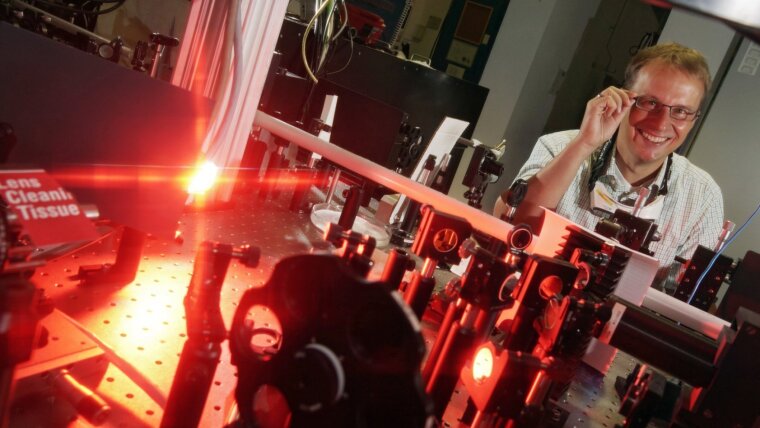
Stefan NOLTE
Image: PrivateProf. Dr. Stefan NOLTE
Email: stefan.nolte@uni-jena.de
Phone: +49 3641-9-47820
Prof. Nolte is the head of the Ultrafast Optics group at the Institute of Applied Physics and Deputy Director of the Fraunhofer Institute for Applied Optics and Precision Engineering IOF, Jena. He is a member of the executive board of the Abbe School of Photonics, a fellow of the Max Planck School of Photonics, and a member of the Center of Medical Optics and Photonics (CeMOP). In December 2013, he has been awarded the Federal German President‘s Award for Innovation in Science and Technology together with Bosch and Trumpf for transferring ultrashort pulse laser processing into industrial mass production.
The Ultrafast Optics Group has a strong expertise in scientific and technical aspects associated with ultrashort laser pulses including their generation, amplification, tailoring and application. A main focus is the interaction of intense ultrashort laser pulses with matter. Ultrashort pulses are used for material processing, allowing highly precise and practically damage and melting-free structuring. In addition, transparent media can be structured within the volume without damaging the surface. The Ultrafast Optics Group was one of the first to demonstrate the true 3D capabilities of this direct writing technique for the fabrication of waveguides within the bulk of glasses. Based on the extension of this work to crystalline media, efficient frequency waveguide converters have been realized in LiNbO3 and also PPLN. In addition, waveguides buried within the bulk of crystalline silicon have been demonstrated for the first time giving rise to new options for connecting optics and electronics on one chip.
Interesting and promising phenomena have been observed when producing 2D coupled waveguide arrays within the bulk of different glasses, which open the potential for new routing and switching applications. These structures are among today's best model systems for investigating linear and nonlinear discrete propagation effects. By applying the femtosecond direct writing technique to existing waveguides, the Ultrafast Optics Group was one of the first to demonstrate the realization of fiber Bragg gratings (FBG) in non-photosensitive fibers using a point-by-point method. In addition, a phase mask scanning technique was developed to allow for the inscription of long and efficient FBGs in various types of fibers (e.g. non-photosensitive, polarization maintaining, active fibers). Recently, an efficient and stable integrated high-power fiber laser was realized using such FBGs. The ultrafast materials processing knowledge is also used for medical applications. The current focus is on the use of ultrashort pulses for the treatment of presbyopia. Here, the goal is to regain the elasticity of the human lens by inducing defined cuts with a femtosecond laser.
Research Areas
The research topic of Prof. Nolte is ultrashort laser pulses with the main focus on ultrashort pulse micromachining and material modification for industrial and medical applications, areas where he has been actively engaged in since the field's inception in the mid-1990s. Current research interests include:
- Linear and nonlinear interaction of light and matter
- Micro- and nanostructuring by ultrashort laser pulses
- Ultrashort pulse laser cutting and welding
- 3D-volume structuring of glasses and crystals
- Fiber and volume Bragg gratings
- Linear and nonlinear optics in discrete systems
- Additive manufacturing using ultrashort laser pulses
- Applications of ultrashort lasers in ophthalmology
- Nonlinear spectroscopy
Teaching Fields
Stefan Nolte is teaching courses ranging from fundamental aspects of physics to state-of-the-art research. He is also responsible for the ASP optics training laboratory, including labwork internships. He gives courses in Atomic and Molecular Physics and Ultrafast Optics.
Research Methods
Our laboratories are equipped with a wide variety of lasers, handling equipment and characterization technology. They include:
- High repetition rate ultrashort pulse laser systems (7 fs to 20 ps) including wavelength conversion (300 nm to 10 µm), and average powers up to 500 W
- High-precision positioning and laser scanner systems
- Equipment for sample preparation and characterization (optical microscopes, electron microscope, Raman microscope, etc.)
- Characterization of spectral and spatial properties of micro- and nanostructured samples
- Characterization of nonlinear spatio-temporal dynamics
Recent Research Results
The Ultrafast Optics group has extensive capabilities to precisely structure virtually any material on a micrometer scale. This includes the defined modification of the optical properties within the volume of transparent materials, which is e.g. used to realize complex coupled waveguide array structures of various three-dimensional geometries. Its potential is exploited for tailoring the flow of light in artificially structured glass. By combining this with the localized generation of so-called nanogratings acting as artificial birefringent structures, integrated optical quantum gates can be realized for quantum optical operations [1].
In addition, we use ultrashort laser pulses to inscribe highly periodic structures into transparent materials. This way we are able to realize Bragg gratings in various fibers, which can be used as efficient fiber-integrated laser mirrors withstanding even highest powers [2]. In addition, the inscription of aperiodic fiber Bragg gratings allows for a precise spectral filtering as required e.g. in astrophotonic applications [3]. When this technique is extended to bulk material, volume Bragg gratings can be generated. We recently managed to inscribe such highly efficient gratings into fluoride glasses, targeting applications as lasers or hyperspectral imaging in the mid-infrared spectral range [4]. For optimizing the laser processing, a detailed spatio-temporal analysis of the laserglass interaction is essential [5].
Apart from structuring and ablation, we apply ultrashort laser pulses for additive manufacturing. The high peak power of these pulses allows to process a large variety of different materials. Currently, we focus on copper, glass as well as lightweight alloys. Here, the ultrashort pulse duration results in extremely fast heating and cooling cycles, allowing e.g. the laser powder bed fusion of hypereutectic alloys [6].
A promising spectroscopic approach for the process analysis of chemical reactions is the coherent anti-Stokes Raman scattering using femtosecond laser pulses (fs-CARS). The short pulse durations enable the excitation of molecular states of a gas, before detrimental molecular collisions take place. This feature makes fs-CARS ideally suited for thermometry and gas concentration measurements under high temperature and high pressure conditions. We recently investigated twobeam fs/ps CARS for effective concentration and temperature measurements in gas mixtures [7].
[1] Lammers et al., Opt. Mat. Express 9, 2560 (2019).
[2] Krämer et al., Opt. Lett. 45, 1447 (2020).
[3] Goebel et al., Opt. Lett. 43, 3794 (2018).
[4] Talbot et al., Opt. Lett. 45, 3625 (2020).
[5] Bergner et al., Appl. Opt. 57, 4618 (2018).
[6] Ullsperger et al., Appl. Phys A 123, 798 (2017).
[7] Ran et al., J Raman Spectrosc. 50, 1268 (2019).
